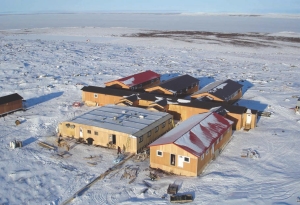The Ferguson Lake base metals project, in Nunavut, will likely post an internal rate of return of 27% based on current nickel and copper prices, Starfield Resources (SRU-T, SRFDF-O) says.
Results of a new scoping study indicate the project will have a net present value of $1.94 billion — at a 10% discount rate — and capital costs of about $1.35 billion.
Annual production is forecast at about 27.5 million lbs. nickel, 43.6 million lbs. copper and 2.9 million lbs. cobalt.
The Toronto-based company says the resources at its wholly owned nickel-copper-platinum-palladium- cobalt property are large enough to support operations there through 2030.
Now it plans to skip the prefeasibility study phase and move straight into a full feasibility, which it hopes to complete by early 2010.
The scoping study was based on an indicated resource for the Main West zone of 15.3 million tonnes grading 0.71% nickel, 1.04% copper and 0.08% cobalt. The analysis also used an inferred resource of 19.4 million tonnes grading 0.68% nickel, 1.13% copper and 0.08% cobalt.
The resource estimate was based on data Starfield collected between 1999 and 2006 (totalling 359 holes and more than 133,200 metres) as well as historical data from the 1950s.
Due to insufficient drilling, the scoping study did not include the project’s eastern zone, which contains about 9.5 million tonnes. Nor did it include platinum or palladium resources in its calculations.
The scoping study also excluded the low-sulphide platinum group element (PGE) style of mineralization hosted in the sulphide intrusive complex. (Additional drilling is scheduled this year to work on a resource estimate for the PGE mineralization.) The potential sale of excess electrical power and sale of other byproducts, such as iron oxide, were also left out of the analysis.
The Ferguson Lake project, 240 km west of Rankin Inlet and 765 km north of Thompson, Man., will initially consist of a small open-pit mine.
Mining from the open pit will start at 3,000 tonnes per day. An underground mine will be developed within one year.
Calculations incorporated into the scoping study also included an ore production rate of 6,000 tonnes per day (2.1 million tonnes per year).
Average annual production would come in at about 27.5 million lbs. nickel, 43.6 million lbs. copper, 2.9 million lbs. cobalt, and 1.6 million tonnes sulphuric acid.
A processing plant will have to be built at Ferguson Lake to crush, clean and grind the massive sulphides into slurry.
Construction will involve a 285- km pipeline to transport the slurry to a metallurgical processing plant near Rankin Inlet. The two facilities will be connected by a 285-km, 11- megawatt power line that follows the same path as the slurry pipeline.
The hydrometallurgical processing plant will extract pure, LMEgradenickel, copper and cobalt metals from the Ferguson Lake massive sulphides at very competitive production costs, the company says.
Electricity will be produced from steam generated from the burning of hydrogen sulphide gas, which is produced during the first stage of leaching. This will supply heat and atthe same time produce a sulphuric acid, which can be sold.
“Our ability to generate our own electricity results in very economical operations, and our proximity to deep water shipping will make it easier for resupply and byproduct transportation,” said the company’s president and chief executive, Andre Douchane, in a statement.
Starfield acquired the property in 1998. Inco, then called the Canadian Nickel Co., discovered it in 1950.
News of the study’s results sent Starfield stock up 17.1%, or 12 apiece, to 82 on a trading volume of more than 576,300 shares.
The company has a 52-week trading range of 22.5-$1.93 and has 301 million outstanding shares.


Be the first to comment on "Starfield likes Ferguson Lake economics"